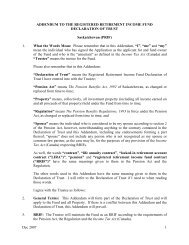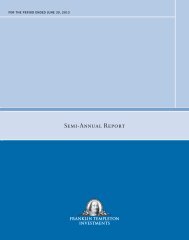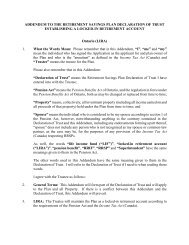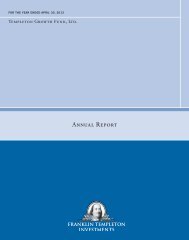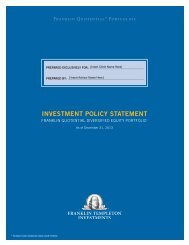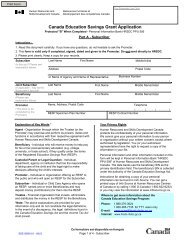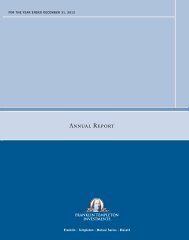The fair value of retained subordinated securities from securitization transactions is determined usingindependent third-party broker or dealer price quotes, and these securities are classified as Level 2. Thebroker or dealer price quotes are evaluated for reasonableness based upon the performance of the underlyingloans and comparable transaction pricing in the securitization market. The fair value of residual interestscurrently is determined using unobservable inputs and classified as Level 3. The residual interests consist ofinterest-only strips receivable and cash on deposit, and are backed by prime, non-prime and sub-primeautomobile loans issued from March 1999 to April 2008. The fair value is estimated using discounted cashflow analyses. Key inputs to the analysis include the excess cash flow discount rate, the cumulative life lossrate, expected weighted-average life and prepayment speed assumption. We develop our key inputs usingour actual portfolio experience and recent market activity for similar transactions. At least one of thesignificant inputs used in the fair valuation is not observable because recent economic events havesignificantly reduced the number of comparable securitization transactions. During fiscal year 2009, werecognized $46.0 million of write-downs to the residual interests primarily due to an increase in thecumulative life loss rate, partially offset by a decrease in the excess cash flow discount rate. We increasedthe cumulative life loss rate assumption from a range of 2.1% to 5.7% at September 30, 2008 to a range of2.4% to 11.4% at September 30, 2009 to reflect increases in experienced and expected losses. This resultedin an increase in the weighted-average assumption for the cumulative life loss rate from 4.2% atSeptember 30, 2008 to 7.4% at September 30, 2009. The excess cash flow discount rate decreased from19.8% at September 30, 2008 to 14.4% at September 30, 2009 as a result of the changing liquidity premiumin the securitization market. The key assumptions and the sensitivity of the fair value of the residualinterests to an immediate adverse change in those assumptions are shown in Note 9 – Securitization ofLoans Held for Sale in the notes to consolidated financial statements in Item 8 of Part II of this Form 10-K.Investment Securities, Available-for-Sale consist primarily of non-consolidated sponsored investmentproducts and debt securities including U.S. government-sponsored enterprise obligations, securities of U.S.states and political subdivisions, securities of the U.S. Treasury and federal agencies, and corporate debtsecurities. Realized gains and losses are included in investment income using either the average cost method orspecific identification method. Unrealized gains and losses are recorded net of tax as part of accumulated othercomprehensive income until realized. The fair value of non-consolidated sponsored investment products isdetermined based on the published net asset values of the sponsored investment products, and they areclassified as Level 1. The fair value of the debt securities is determined using quoted market prices orindependent third-party broker or dealer price quotes, which are evaluated for reasonableness, and they aregenerally classified as Level 2, except for certain U.S. Treasury securities which are classified as Level 1.Loans Held for Sale consist of retail installment loan sale contracts held for sale in securitizationtransactions. The contracts are secured by new and used automobiles purchased from motor vehicle dealers.The fair value of loans held for sale generally is estimated based on the whole loan market price that wouldbe received if the loans were sold in their current condition, which may include adjustments based on thecomposition of the loan portfolio and liquidity factors. As a result of recent economic conditions,observable whole loan prices for comparable portfolios of automobile loans sold have not been readilyavailable. Therefore, the fair value currently is determined by using discounted cash flow analyses withestimated discount rates for loans with similar terms and collateral. Accordingly, loans held for salecurrently are classified as Level 3.While we believe the valuation methodologies described above are appropriate, the use of differentmethodologies or assumptions to determine the fair value could result in a different estimate of fair value atthe reporting date.Investments are evaluated for other-than-temporary impairment on a quarterly basis when the cost ofan investment exceeds its fair value. For available-for-sale equity securities, we consider many factors,including the severity and duration of the decline in the fair value below cost, our intent and ability to hold54
the security for a period of time sufficient for an anticipated recovery in fair value, and the financialcondition and specific events related to the issuer. When an impairment of an available-for-sale equitysecurity is determined to be other-than-temporary, we recognize the impairment in earnings. Foravailable-for-sale debt securities, if we intend to sell or it is more likely than not that we will be required tosell a security before recovery of its amortized cost, we record the entire impairment in earnings. If we donot intend to sell or it is not more likely than not that we will be required to sell the security beforeanticipated recovery of its amortized cost, we separate the impairment into the amount of the totalimpairment related to the credit loss and the amount of the total impairment related to all other factors. Thecredit loss component is the difference between the security’s amortized cost and the present value of theexpected cash flows. The credit loss component is recognized in earnings and the losses related to all otherfactors are recognized in accumulated other comprehensive income. While we believe that we haveaccurately estimated the amount of other-than-temporary impairment in our portfolio, different assumptionscould result in changes to the recorded amounts in our consolidated financial statements.Goodwill and Other Intangible AssetsGoodwill represents the excess cost of a business acquisition over the fair value of the net assetsacquired. Intangible assets consist primarily of mutual fund management contracts and customer base assetsresulting from business acquisitions. We amortize intangible assets over their estimated useful lives, whichrange from seven to 15 years, using the straight-line method, unless the asset is determined to have anindefinite useful life. Indefinite-lived intangible assets primarily represent contracts to manage mutual fundassets for which there is no foreseeable limit on the contract period.We make significant estimates and assumptions when valuing goodwill and other intangible assets inconnection with the initial purchase price allocation of an acquired entity, as well as when evaluatingimpairment of goodwill and other intangible assets on an ongoing basis.Goodwill is tested for impairment annually and when an event occurs or circumstances change thatmore likely than not reduce the fair value of a reporting unit below its carrying value. Historically, wecompleted our annual goodwill impairment test as of October 1 of each fiscal year. During fiscal year 2009,we changed our annual impairment test date from October 1 to August 1 of each year. We believe theAugust 1 date better aligns our annual goodwill impairment test with the budget data developed inconnection with the budgeting process that takes place in July and August. In addition, the annualimpairment test will be completed during our fourth fiscal quarter using the most recent financialinformation such that the results will better reflect the fiscal year being reported. This change to the date ofour annual goodwill impairment test constitutes a change in the method of applying an accounting principle.We believe that this change in accounting principle is preferable and we filed a letter of preferability fromour independent registered public accounting firm regarding this change in accounting principle as anexhibit to our Form 10-Q for the quarter ended March 31, 2009.Our goodwill impairment test involves a two-step process. The first step requires the identification ofthe reporting units, and comparison of the fair value of each of these reporting units to the respectivecarrying value. If the carrying value is less than the fair value, no impairment exists and the second step isnot performed. If the carrying value is higher than the fair value, there is an indication that impairment mayexist and the second step is performed to compute the amount of the impairment. In the second step, theimpairment is computed by comparing the implied fair value of reporting unit goodwill with the carryingvalue of that goodwill. We have two reporting units, investment management and related services andbanking/finance, which are the same as our operating segments. All goodwill has been assigned to theinvestment management and related services reporting unit.55
- Page 1 and 2:
G A I N F R O M O U R P E R S P E C
- Page 3 and 4:
Letter to StockholdersGregory E. Jo
- Page 5 and 6:
LETTER TO STOCKHOLDERSHaving announ
- Page 7 and 8:
Directors and OfficersDirectorsChar
- Page 9 and 10:
Performance GraphThe following perf
- Page 11 and 12:
(MARK ONE)UNITED STATESSECURITIES A
- Page 14 and 15: operational and other services requ
- Page 16 and 17: A. Assets Under Management (“AUM
- Page 18 and 19: 60 days. If agreements representing
- Page 20 and 21: Similar arrangements exist with the
- Page 22 and 23: We generally operate our institutio
- Page 24 and 25: Franklin Templeton Variable Insuran
- Page 26 and 27: CATEGORY(and approximate amount of
- Page 28 and 29: The following table sets forth the
- Page 30 and 31: Korea; the Commission de Surveillan
- Page 32 and 33: COMPETITIONThe financial services i
- Page 34 and 35: or other efforts successfully stabi
- Page 36 and 37: and, consequently, we are incurring
- Page 38 and 39: such as information, systems and te
- Page 40 and 41: like our business, is based in part
- Page 42 and 43: orrowing costs and limit our access
- Page 44 and 45: director of various subsidiaries of
- Page 46 and 47: PART IIItem 5. Market for Registran
- Page 48 and 49: OverviewWe are a global investment
- Page 50 and 51: Net income decreased in fiscal year
- Page 52 and 53: Investment Management Fee RateThe f
- Page 54 and 55: accounts closed in a calendar year
- Page 56 and 57: Information Systems, Technology and
- Page 58 and 59: Our investments in sponsored invest
- Page 60 and 61: At September 30, 2009, we had $355.
- Page 62 and 63: Off-Balance Sheet ArrangementsAs of
- Page 66 and 67: Indefinite-lived intangible assets
- Page 68 and 69: the position will be sustained upon
- Page 70 and 71: Selected Quarterly Financial Data (
- Page 72 and 73: The following is a summary of the e
- Page 74 and 75: Item 8.Financial Statements and Sup
- Page 76 and 77: REPORT OF INDEPENDENT REGISTERED PU
- Page 78 and 79: CONSOLIDATED BALANCE SHEETS(dollars
- Page 80 and 81: CONSOLIDATED STATEMENTS OF STOCKHOL
- Page 82 and 83: CONSOLIDATED STATEMENTS OF CASH FLO
- Page 84 and 85: Fair Value Measurements. The Compan
- Page 86 and 87: Company held interest-rate swap agr
- Page 88 and 89: not performed. If the carrying valu
- Page 90 and 91: Accumulated Other Comprehensive Inc
- Page 92 and 93: acquisition cost was allocated to t
- Page 94 and 95: FHLB borrowings and amounts availab
- Page 96 and 97: The Company recognized other-than-t
- Page 98 and 99: The changes in Level 3 assets measu
- Page 100 and 101: Changes in the allowance for loan l
- Page 102 and 103: Company sold retained subordinated
- Page 104 and 105: Certain of the goodwill and intangi
- Page 106 and 107: At September 30, 2009, maturities o
- Page 108 and 109: The components of the net deferred
- Page 110 and 111: At September 30, 2009, the banking/
- Page 112 and 113: Total assets under management of in
- Page 114 and 115:
Stock OptionsThe following table su
- Page 116 and 117:
The following tables summarize info
- Page 118 and 119:
Operating revenues of the banking/f
- Page 120 and 121:
minimum Tier 1 and Total risk-based
- Page 122 and 123:
PART IIIItem 10. Directors, Executi
- Page 124 and 125:
Item 15.(a)(1)(a)(2)(a)(3)PART IVEx
- Page 126 and 127:
Exhibit No.Description10.17 Represe
- Page 128 and 129:
Exhibit No.Description12 Computatio
- Page 130 and 131:
Exhibit No.DescriptionEXHIBIT INDEX
- Page 132 and 133:
Exhibit No.Description10.22 Amendme
- Page 134 and 135:
(dollars in thousands)COMPUTATION O
- Page 136 and 137:
NameState or Nation ofIncorporation
- Page 138 and 139:
CONSENT OF INDEPENDENT REGISTERED P
- Page 140 and 141:
EXHIBIT 31.2CERTIFICATIONI, Kenneth
- Page 142 and 143:
CERTIFICATION PURSUANT TO 18 U.S.C.
- Page 144:
One Franklin ParkwaySan Mateo, CA 9



